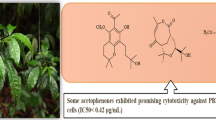Abstract
In the present contribution, we have used petra, osiris and molinspiration (POM) analyses to identify pharmacophores and anti-pharmacophores for antibacterial/antifungal activity of some benzothiophene derivatives (THBT). Lipophilicity and presence of tautomerism processes were the major factors that governed the orientation to antibacterial and/or antiviral activity. It was also observed that these compounds POM analyzed have a closed pharmacophore site which might be bioactivity low. Further, we have carried out receptor-based electrostatic analysis to confirm the electronic, steric and hydrophobic requirements for future modifications. The POM analyses provide substantial idea about the structural features responsible for their combined antibacterial/antifungal activity and provide guidelines for further modifications, with the aim of improving the activity and selectivity of designed drugs targeting potentially the drug-resistant microorganisms.
Graphical Abstract
The impact of intramolecular OH/N and NH/N interactions on bioactivity of pharmacophores sites of THBT series 5–15 is established. The POM analyses of 2,3-armed 4,5,6,7-tetrahydro-1-benzothiophenes (THBT) 5–15 provide substantial idea about the structural features responsible for their failure as dual antibacterial/antifungal agents and provide guidelines for further modifications, with the aim of improving the activity and selectivity of designed drugs targeting potentially the bacterial and fungal enzymes responsible of diseases.










Similar content being viewed by others
References
Bhaskar VH, Kumar PP, Sangameshwaran B (2007) Synthesis, antimicrobial and antihyperlipidemic activities of some 4-substituted-5,6,7,8-tetrahydro[1]benzo- thieno[2,3-d]pyrimidines. Asian J Chem 19:5187–5194
Chiu FCK, Lo CMY (2000) Observation of amide anions in solution by electrospray ionization mass spectrometry. J Am Soc Mass Spectrom 11:1061–1064
Chohan ZH, Youssoufi MH, Jarrahpour A, Hadda TB (2010) Identification of inhibition: indolenyl sulphonamide derivatives. Eur J Med Chem 45:1189–1199
Ertl P, Rohde B, Selzer P (2000) Fast calculation of molecular polar surface area (PSA) as a sum of fragment-based contributions and its application to the prediction of drug transport properties. J Med Chem 43:371–3714
Ferreira ICFR, Calhelha RC, Estevinho LM, Queiroz MJRP (2004) Screening of antimicrobial activity of diarylamines in the 2,3,5-trimethylbenzo[b]thiophene series: a structure–activity evaluation study. Bioorg Med Chem Lett 14:5831–5833
Hadda TB, Ali MA, Masand V, Gharby S, Fergoug T, Warad I (2013a) Tautomeric origin of dual effects of N1-nicotinoyl-3-(4′-hydroxy-3′-methyl phenyl)-5-[(sub)phenyl]-2-pyrazolines on bacterial and viral strains: POM analyses as new efficient bioinformatics’ platform to predict and optimize bioactivity of drugs. Med Chem Res 22:1438–1449
Hadda TB, Kerbal A, Bennani B, Al Houari G, Daoudi M, Leite ACL, Masand VH, Jawarkar RD, Charrouf Z (2013b) Molecular drug design, synthesis and pharmacophore site identification of spiroheterocyclic compounds: trypanosoma crusi inhibiting studies. Med Chem Res 22:57–69
Hadda TB, Fathi J, Chafchaouni I, Masand V, Charrouf Z, Chohan ZH, Jawarkar R, Fergoug T (2013c) Computational POM and 3D-QSAR evaluation of experimental in vitro HIV-1 integrase inhibition of amide-containing di-ketoacids. Med Chem Res 22:1456–1464
Iyengar B and Remers W (2010) Espacenet Registre européen des brevets, Patent No EP1461316 B1, EP1461316A2, US6476236
Jarrahpour A, Motamedifar M, Zareil M, Youssoufi MH, Mimouni M, Chohan ZH, Hadda TB (2010) Petra, osiris and molinspiration together as a guide in drug design: predictions and correlation structure/antibacterial activity relationships of new N-Sulfonyl monocyclic β-lactams. Phosphorus, Sulfur, and Silicon Relat Elem 185(2):491–497. doi:10.1080/10426500902953953
Jarrahpour A, Fathi J, Mimouni M, Hadda TB, Sheikh J, Chohan ZH, Parvez A (2012) Petra, osiris and molinspiration (POM) together as a successful support in drug design: antibacterial activity and biopharmaceutical characterization of some azo Schiff bases. Med Chem Res 21(8):1984–1990. doi:10.1007/s00044-011-9723-0
Ozcelik B, Sheikh J, Orhan I, Juneja H, Bennani B, Kerbal A, Cavalcanti SMT, Leite ACL and Hadda TB (2012) Outstanding effect of the conformational restriction of isoquinolines: Hints for the development of optimized antimicrobial agents, Res Chem Intermed. (http://link.springer.com/article/10.1007%2Fs11164-012-0808-2)
Parvez A, Jyotsna M, Youssoufi MH, Hadda TB (2010a) Theoretical calculations and experimental verification of the antibacterial potential of some monocyclic beta-lactames containing two synergetic buried antibacterial pharmacophore sites. Phosphorus, Sulfur, and Silicon Relat Elem 185(7):1500–1510. doi:10.1080/10426500903095556
Parvez A, Meshram J, Tiwari V, Sheikh J, Dongre R, Youssoufi MH, Hadda TB (2010b) Pharmacophores modeling in terms of prediction of theoretical physicochemical properties and verification by experimental correlations of novel coumarin derivatives produced via Betti’s protocol. Eur J Med Chem 45(9):4370–4378
Ryu CK, Lee SK, Han JY, Jung OJ, Lee JY, Jeong SH (2005) Synthesis and antifungal activity of 5-arylamino-4,7-dioxobenzo[b]thiophenes. Bioorg Med Chem Lett 15(10):2617–2620
Sheikh J, Hadda TB (2013) Antibacterial, antifungal and antioxidant activity of some new water-soluble b-diketones. Med Chem Res 22:964–975
Singh D, Mohan S, Sharma PC, Sarvanan J (2007) Synthesis and evaluation of some novel piperidino thiophenes as potential antioxidant and anti-inflammatory agents. Acta Pharm Sci 49:29–38
Srivastava S and Das B (2009) Antibacterial and in vivo and in vitro anti-inflammatory activity of some novel substituted thienopyrimidinone, Inter J Pharm Sci 1779–1783
Srivastava S, Das B (2011) Synthesis and evaluation of some novel thiophenes as potential antibacterial and mycolytic Agents. Der Pharma Chemica 3:103–111
Srivastava S, Das B, Mohan S (2007) Synthesis and antibacterial activity of some novel thiadiazolo thienopyrimidines. Asian J Chem 19:2813–2817
Tehranchian S, Akbarzadeh T, Fazeli MR, Jamalifar H, Shafiee A (2005) Synthesis and antibacterial activity of 1-[1,2,4-triazol-3-yl] and 1-[1,3,4-thiadiazol-2-yl]-3-methylthio-6,7-dihydrobenzo[c]thiophen-4(5H)ones. Bioorg Med Chem Lett 15:1023–1025
Waring MJ, Hadda TB, Kotchevar AT, Ramdani A, Touzani R, Elkadiri S, Hakkou A, Bouakka M, Ellis T (2002) 2,3-bifunctionalized quinoxalines: synthesis DNA interactions and evaluation of anticancer, anti-tuberculosis and antifungal activity. Molecules 7:641–656
Wujec M, Pitucha M, Dobosz M, Kosikowska U, Malm A (2004) Synthesis and potential antimycotic activity of 4-substituted-3-(thiophene-2-yl-methyl)-delta-2-1,2,4-triazoline-5-thiones. Acta Pharm 54:251–260
Acknowledgments
Prof. T. Ben Hadda would like to thank ACTELION; the Biopharmaceutical Company of Swiss, for molecular properties calculations.
Author information
Authors and Affiliations
Corresponding author
Rights and permissions
About this article
Cite this article
Hadda, T.B., Srivastava, S., Das, B. et al. POM analyses of antimicrobial activity of some 2,3-armed 4,5,6,7-tetrahydro-1-benzothiophenes: favourable and unfavourable physico-chemical parameters in design of antibacterial and mycolytic agents. Med Chem Res 23, 995–1003 (2014). https://doi.org/10.1007/s00044-013-0707-0
Received:
Accepted:
Published:
Issue Date:
DOI: https://doi.org/10.1007/s00044-013-0707-0




